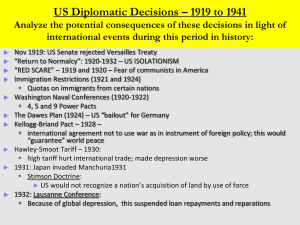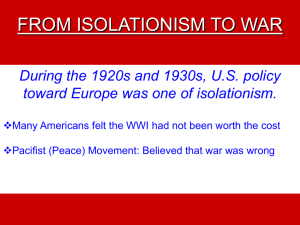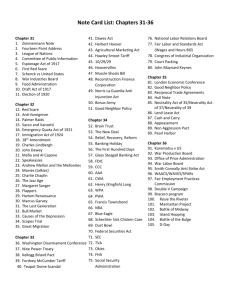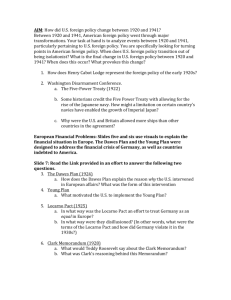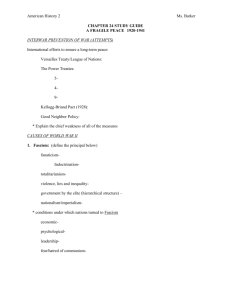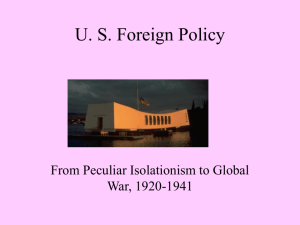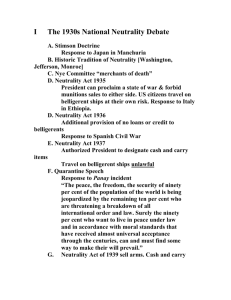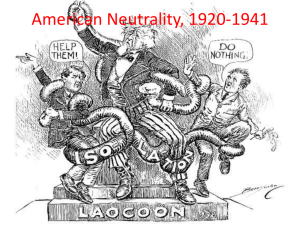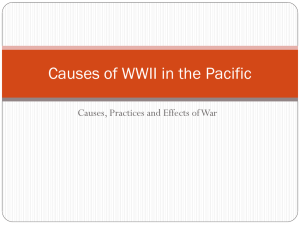US Diplomacy between 1919 and 1941
advertisement
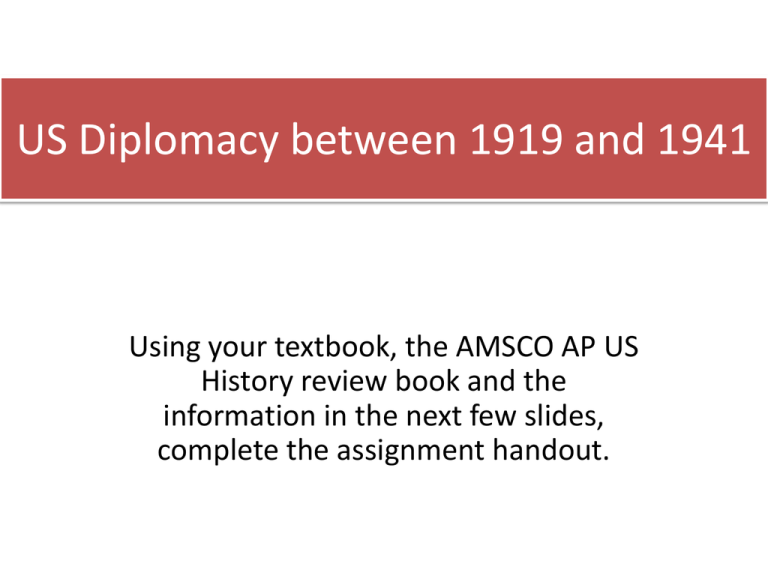
US Diplomacy between 1919 and 1941 Using your textbook, the AMSCO AP US History review book and the information in the next few slides, complete the assignment handout. US Diplomatic Decisions – 1919 to 1941 Analyze the potential consequences of these decisions in light of international events during this period in history: ► ► ► ► ► ► ► ► ► ► Nov 1919: US Senate rejected Versailles Treaty and League of Nations “Return to Normalcy”: 1920-1932 DIPLOMATIC ISOLATIONISM Independent Internationalism “RED SCARE” – fear of communism and anarchism in US (1919 and 1920) Immigration Restrictions Emergency Quota Act (1921), Immigration Act of 1924 Washington Naval Conferences (1920-1922) 4 power pact (Imperialism in Asia) 5 power pact (Navies-5:5:3:1.67:1.67) 9 power pact (Open Door in China) The Dawes Plan (1924) – US “bailout” for Germany Kellogg-Briand Pact – 1928 Fordney-McCumber Tariff (1922) and Hawley-Smoot Tariff (1930) 1931: Japan invaded Manchuria Stimson Doctrine: US would not recognize a nation’s acquisition of land by use of force 1932: Lausanne Conference: Suspended loan repayments and reparations US Foreign Policy Responses After Hitler’s Rise to Power Is there a “hidden agenda” of US diplomacy? ► ► ► ► ► ► 1933: Good Neighbor Policy (Herbert Hoover’s idea…) To improve relations damaged by “big stick policy” in Latin America 1933: Diplomatic recognition of the USSR Diplomatic relations between the US and USSR begin for the first time. 1933: London Conference to stabilize world economies; US decided not to participate 1934: Tydings-McDuffie Act Philippines independence by 1946. 1934: Reciprocal Trade Act Reduced the US tariff if its international trading partners did the same. 1934-5: The Nye Commission Government committee that concluded US involvement in WW 1 was caused by “war profiteers” (“Merchants of Death”) who traded with belligerents between 1914 and 1917. US would not make the same mistake twice… US Diplomatic Responses to Global Aggression: 1935-1939 ► 1935: Italian invasion of Ethiopia: Nye Report is issued, 1st NEUTRALITY ACT (arms embargo on belligerents) ► 1936: Germany retakes the Rhineland , and Spanish Civil War begins: 2nd NEUTRALITY ACT (added: no loans to belligerents) ► 1937: Japanese invasion of China and “Panay Incident”: 3rd NEUTRALITY ACT (added: no trade without “cash and carry”) QUARANTINE speech (plus: “moral embargo”) ► 1938: Austrian “Anschluss”, Rome-Berlin Axis, Anti-Comintern Pact, the Sudetenland and Czechoslovakia: NO DIPLOMATIC MOVES BY US ► 1938: The Ludlow Resolution: a national referendum on declaration of war ► 1939: September 1: Germany invaded Poland and the USSR occupied Latvia, Lithuania, Estonia and Finland AND it’s “part” of Eastern Poland: “America First Committee”: strong isolationist “pressure” group 4th NEUTRALITY ACT (lifted arms embargo on cash and carry basis) Pan-American Conference: Declaration of Panama June 1940 to June 1941: The War and US ‘Neutrality’ Continue... ►Alien Registration Act (June) all resident aliens had to be registered with the US Government; had to explain their political beliefs to US officials. ►Pan-American Conference: Declaration of Havana (July) “Aggression against one nation in the Western Hemisphere was aggression against all”. ►Selective Service Act (September) peace-time military draft ►Destroyers for Bases (September) GB got US naval destroyers, US got use of British naval bases around the world ►Lend-Lease Act (December) US supplied nations fighting fascism (included USSR)-US became the “arsenal of democracy” ►The Four Freedoms Speech (January ‘41) Freedom of speech/expression, freedom of worship, freedom from want, freedom from fear. ►ABC-1 Talks (January-March ‘41) Secret meetings between FDR and British PM Winston Churchill. Defeating Germany was the priority if the war became “two theater” war. (“Europe first” or “Get Hitler First” strategy) ►The ATLANTIC CHARTER (July 1941) July 1941: The Atlantic Charter US and GB “secret war aims” 1. 2. 3. 4. 5. 6. 7. 8. No territorial gains were to be sought by USA or Britain. Pledge to liberate AXIS-occupied lands; “Territorial adjustments must be in accordance with the wishes of the peoples concerned”; Trade barriers were to be lowered; Promote global economic cooperation and advancement of social welfare; Freedom from want and fear; Freedom of the seas; Disarmament of aggressor nations; postwar common disarmament. How can these provisions be enforced? Does this look familiar to you?
